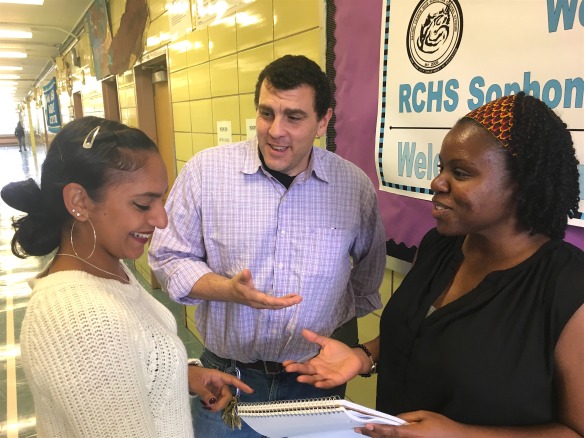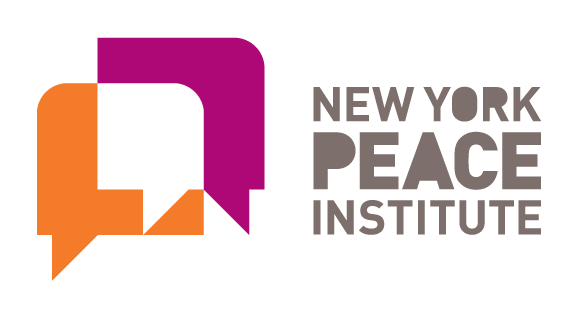Guest post: From suspension to restoration on Coney Island.

Our Restorative Justice Coordinator Skye Roper-Moses and Assistant Principal Calise working with a student at Rachel Carson High School. (r-l).
Alternatives to Suspension: Rachel Carson High School and Restorative Justice By Anne Marie McFadyen and Emily Sernaker
Michael Calise was tired of suspending students. As a high school Assistant Principal, suspension was one of his only available consequences. Looking for other options, he signed up to attend a Restorative Justice Conference hoping he would discover more effective ways of approaching school discipline.
“There are a lot of mandates to get rid of kids when there’s a problem,” says Mr. Calise. “But it doesn’t work. It doesn’t decrease the recidivism rate. Every time we decided to suspend, it never actually fixed the interaction”.
Mr. Calise is the driving force behind Rachel Carson High School’s efforts to move toward a restorative response for dealing with discipline issues. Every day he works alongside Skye Roper-Moses, New York Peace Institute’s Restorative Justice Coordinator. New York Peace Institute’s presence at the school has been made possible thanks to funding from the Brooklyn Community Foundation, who is committed to giving the school the support they need to succeed. The Restorative Justice Project began in October 2015 to introduce a more positive discipline code at the school’s Coney Island campus, and has dealt with every sort of infraction from online bullying to physical fights. Mr. Calise already sees the early signs of culture transformation. “Nine out of ten times, I’ve seen that when you mediate, there’s no repeat of the incident,” he says.
In her role as Restorative Justice Coordinator, Mrs. Roper-Moses is very much a member of the school community. “The Rachel Carson High School environment is already one built on a foundation of respect and care. I’m here to see how we can make these relationships stronger and enhance community connections,” says Mrs. Roper-Moses.
Mrs. Roper-Moses works closely with students and faculty to support the school in putting relationships first when harm has been done. Instead of seeing a hallway fight as a behavior to be punished, she encourages students and staff to view it as an interaction that has hurt relationships and damaged the school community. Students don’t have to be suspended for infractions such as fighting. They can be invited to be part of a restorative process that asks them to meet with those impacted by the incident, take ownership of the behavior and take responsibility for making amends.
For example, when fights occur on campus Mrs. Roper-Moses meets with students one-on-one. She listens to their accounts of the altercation and asks questions regarding safety and hopes for the future. She then asks if they would be willing to participate in a group circle. These circles often include the main students in the fight, other students involved, school counselors, and disciplinary staff. Roper-Moses anchors the discussion with key questions, such as:
- What happened?
- How were you impacted, and how do you think others were impacted?
- What do you want to happen going forward?
- How can the harm that was done be repaired?
The last question is especially important. Individuals who were harmed can express what they need to make things right. If everyone involved can agree on a meaningful action to make amends, students who committed the harm can be welcomed back into the community and avoid suspension. If not, this incident could be on their record. Mr. Calise tells students: “If you are proactive and accountable I promise to do what I can to work with you.”

Mrs. Roper-Moses teaching restorative justice to a group of students.
Circles don’t just change punishments; they change how students think about school and how schools think about students. Here is Jeff’s experience:
Jeff is a 10th grade student who was halfway out the door when Mrs. Roper-Moses first met him. Jeff got into verbal and physical fights when he felt he was being wronged. The incidents were adding up.
When Jeff returned from suspension staff tried to engage him as much as possible, with varying degrees of success. On bad days his fights spilled over into classrooms and hallways. Jeff felt like he didn’t belong in school and no one was on his side. His behavior was more and more disruptive to the school community.
Mr. Calise could see that suspension wasn’t making the situation better for Jeff. Mr. Calise committed to finding a new way to deal with the issues. He tried a restorative approach that included Jeff’s peers to help him reset his relationships. Additional mediations with his teachers put the issues out in the open. It took time, but the different approach helped Jeff see that people genuinely wanted him in school. He became less defensive.
The restorative practices have gradually led to progress. Jeff has found his voice so when he does have issues he can speak with Mr. Calise, other staff or students to address the issue. Jeff is making real progress and has avoided suspension this year. He still experiences challenges but a restorative chat often helps diffuse his frustrations. He gets support to consider the impact of his behavior and actions.
The results from the first year of the Restorative Justice Project are impressive. In just 12 months, Rachel Carson High School suspensions were cut in half; a major success. However, the largest challenge continues to be consistent integration within school policies and culture. Now that the school has seen proof of concept, the challenge ahead lies in bringing the approach to scale, so that it is an essential part of the school’s culture. Sometimes the administration and faculty members choose a punitive response, but more and more they trust the restorative approach.

Mrs. Roper-Moses counseling a student.
New York Peace Institute is proud to have Restorative Justice programming, and is currently working in two schools in Coney Island and Harlem. Coordinators like Mrs. Roper-Moses create systems for continuous evaluation, assessment, goal-setting, and ongoing support for new and established teachers. They work with the school to identify appropriate measures of success while determining long-term benchmarks.
“Be patient and stick with it,” Mr. Calise tells other schools that are adopting the model. “Choosing this approach is certainly a leap of faith at first. It requires willingness to constantly adapt and improve.” For Rachel Carson High School, that investment has already proven valuable. “We want students to find restorative approaches to solving problems,” says Mr. Calise. “There are plenty of people in prison who grew up with only punitive discipline.”
*Student name has been changed for confidentiality

